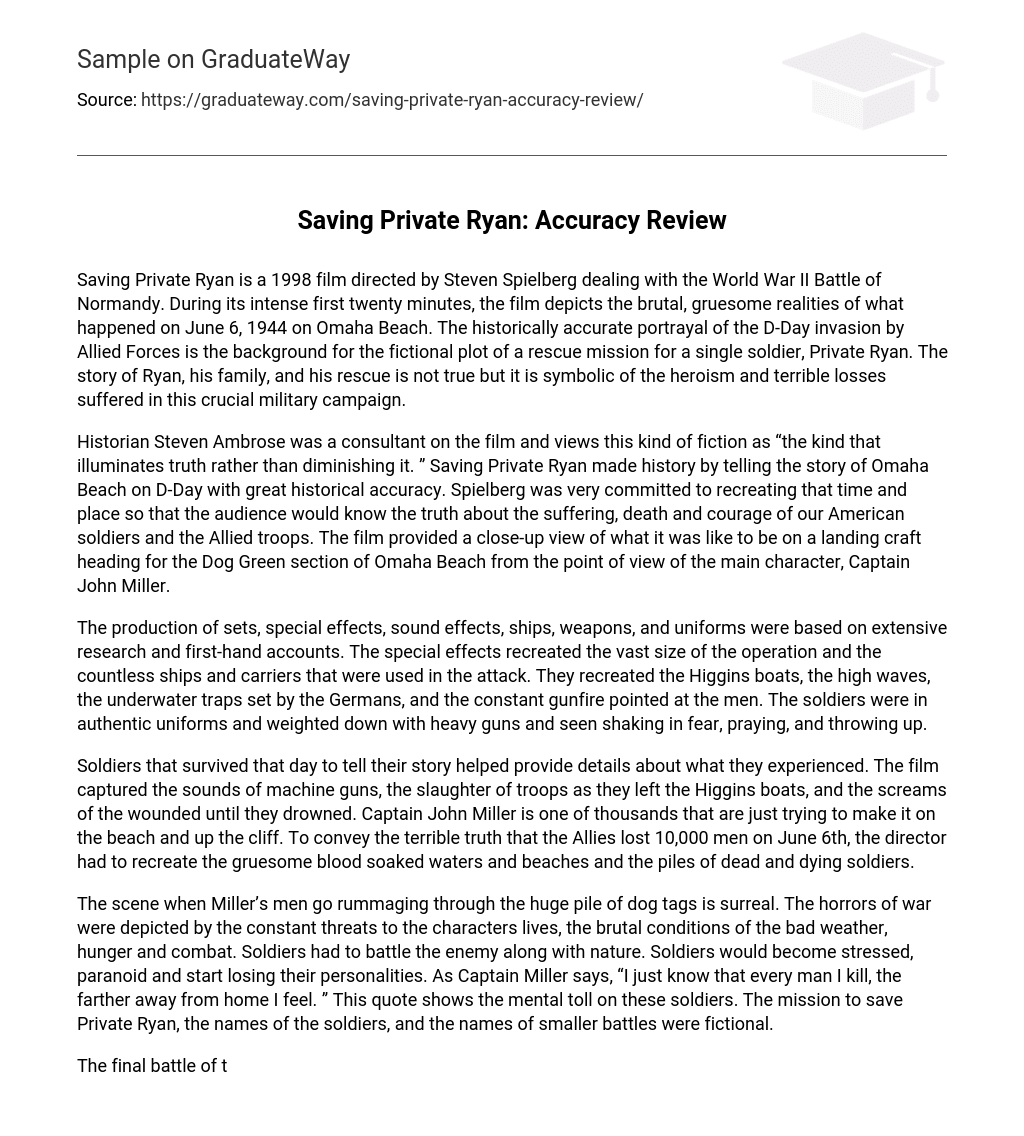Saving Private Ryan is a 1998 film directed by Steven Spielberg dealing with the World War II Battle of Normandy. During its intense first twenty minutes, the film depicts the brutal, gruesome realities of what happened on June 6, 1944 on Omaha Beach. The historically accurate portrayal of the D-Day invasion by Allied Forces is the background for the fictional plot of a rescue mission for a single soldier, Private Ryan. The story of Ryan, his family, and his rescue is not true but it is symbolic of the heroism and terrible losses suffered in this crucial military campaign.
Historian Steven Ambrose was a consultant on the film and views this kind of fiction as “the kind that illuminates truth rather than diminishing it. ” Saving Private Ryan made history by telling the story of Omaha Beach on D-Day with great historical accuracy. Spielberg was very committed to recreating that time and place so that the audience would know the truth about the suffering, death and courage of our American soldiers and the Allied troops. The film provided a close-up view of what it was like to be on a landing craft heading for the Dog Green section of Omaha Beach from the point of view of the main character, Captain John Miller.
The production of sets, special effects, sound effects, ships, weapons, and uniforms were based on extensive research and first-hand accounts. The special effects recreated the vast size of the operation and the countless ships and carriers that were used in the attack. They recreated the Higgins boats, the high waves, the underwater traps set by the Germans, and the constant gunfire pointed at the men. The soldiers were in authentic uniforms and weighted down with heavy guns and seen shaking in fear, praying, and throwing up.
Soldiers that survived that day to tell their story helped provide details about what they experienced. The film captured the sounds of machine guns, the slaughter of troops as they left the Higgins boats, and the screams of the wounded until they drowned. Captain John Miller is one of thousands that are just trying to make it on the beach and up the cliff. To convey the terrible truth that the Allies lost 10,000 men on June 6th, the director had to recreate the gruesome blood soaked waters and beaches and the piles of dead and dying soldiers.
The scene when Miller’s men go rummaging through the huge pile of dog tags is surreal. The horrors of war were depicted by the constant threats to the characters lives, the brutal conditions of the bad weather, hunger and combat. Soldiers had to battle the enemy along with nature. Soldiers would become stressed, paranoid and start losing their personalities. As Captain Miller says, “I just know that every man I kill, the farther away from home I feel. ” This quote shows the mental toll on these soldiers. The mission to save Private Ryan, the names of the soldiers, and the names of smaller battles were fictional.
The final battle of the movie at “Romelle” did not happen, and Romelle is actually a German Field Commander during World War II. There was no Captain John Miller of the 2nd Rangers either. The mission to find the fictitious character, Private Ryan, never happened but Private Ryan was modeled after a soldier named Frederick “Fritz” Niland from the 101st Airborne Division. Niland was one of four brothers and his other three brothers were killed in the war. His mom received the death notifications all at once, and Niland was sent home to the U. S. There was no record of a rescue mission for Fritz Niland.
Captain Miller last words were “James… earn this. Earn it. ” Miller was not a real soldier and his last words in the film were fictional but they capture an important message about the horrible realities of World War II. It is how our freedom was won. We should earn it.
References
http://amankarios1. umwblogs. org/historical-accuracy/
http://www. strategypage. com/moviereviews/default. asp? target=Saving%20Private%20Ryan%20
http://www. channel4. com/history/microsites/H/history/e-h/film-saving. html
http://www. imdb. com/title/tt0120815/quotes





